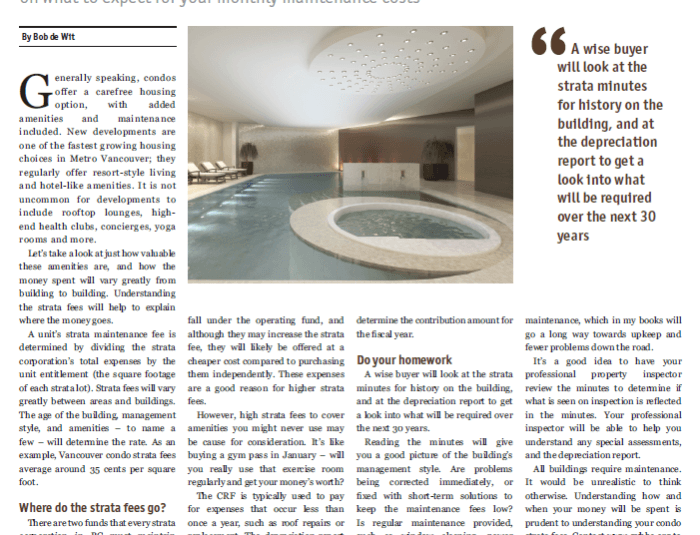How to assess and plan for condo fees

By Bob de Wit
They are the added costs of condominium living. GVHBA’s Bob de Wit offers advice on what to expct for your monthly maintenance costs.
Generally speaking, condos offer a carefree housing option, with the added amenities and maintenance included. New developments are one of the fastest growing housing choices in Metro Vancouver; they regularly offer resort-style living and hotel-like amenities. It is not common for developments to include rooftop lounges, high-end health clubs, concierges, yoga rooms and more.
Let’s take a look at just how valuable these amenities are, and how the money spent will vary greatly from building to building. Understanding the strate fees will help to explain where the money goes.
A unit’s strata maintenance fee is determined by dividing the strata corporation’s total expenses by the unit entitlement (the square footage of each strata lot). Strata fees will vary greatly between areas and buildings. The age of the building, management style, and amenities – to name a few – will determine the rate. As an example, Vancouver condo strata feeds average around 35 cents per square foot.
Where do the strata fees go?
There are two funds that every strata corporation in BC must maintain that are funded by your maintenance fees: the operating fund; and the contingency reserve fund (CRF).
The operating fund is what used to pay for common expenses that occur more than once over the course of a year. As an example, heating, cable, and Internet are sometimes included in the strata fee. These would fall under the operating fund, and although they may increase the strata fee, they will likely be offered at a cheaper cost compare to purchasing them independently. These expenses are a good reason for higher strata fees.
However, high strata fees to cover amenities you might never use may be cause for consideration. It’s like buying a gym pass in January – will you really use that exercise room regularly and get your money’s worth?
The CRF is typically used to pay for expenses that occur less than once a year, such a roof repairs or replacement. The depreciation report will help strata corporations plan for annual and long-term repairs. It will also disclose the financial obligations required now and in the future. Strata corporations control their long-term planning by addressing CRF contributions as part of the annual budget. A majority vote of the owners at the annual general meeting will determine the contribution amount for the fiscal year.
Do your homework
A wise buyer will look at the strata minutes for history on the building, and at the depreciation report to get a look into what will be required over the next 30 years.
Reading the minutes will give you a good picture of the building’s management style. Are problems being corrected immediately, or fixed with short-term solutions to keep the maintenance fees low? Is regular maintenance provided, such as window cleaning, power washing, etc.? Higher strata fees in a building may be a result of regular maintenance, which in my books will go a long way towards upkeep and fewer problems down the road.
It’s a good idea to have your professional property inspector review the minutes to determine if what is seen on inspection is reflected in the minutes. Your professional inspector will be able to help you understand any special assessments, and the depreciation report.
All buildings require maintenance. It would be unrealistic to think otherwise. Understanding how and when your money will be spent is prudent to understanding your condo strata fees. Contact www.gvhba.org to find a professional building inspector and other home-buying resources.
Bob de Wit – is the CEO of the Greater Vancouver Home Builders’ Assosiation (GVHBA), representing the residential construction industry in the Greater Vancouver Area. Celebrating 40 years in 2014, GVHBA has more than 880 members and is proudly affiliated with the provincial and national Canadian Home Builders’ Associations. Bob@gvhba.org.
Original Source: West Coast Condominium March 25, 2016
Original article: The Province
Read original aricle here.
